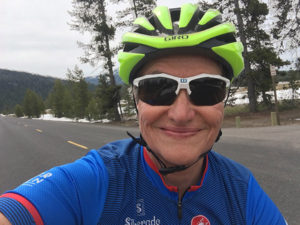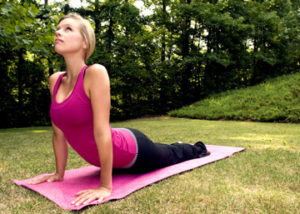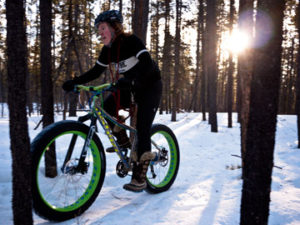 Over the next five months or so we’ll post a series of monthly blogs to provide you some training guidelines that will help you have the best experience possible on this year’s BRNW rides. We’ll provide two different training tracks, so to speak – one with more basic suggestions to give you a general idea of where you should be in your training overall, and more detailed recommendations that are closer to a formal training plan. Choose the level of detail that works best for you, and get ready to enjoy your summer tour(s)!
Over the next five months or so we’ll post a series of monthly blogs to provide you some training guidelines that will help you have the best experience possible on this year’s BRNW rides. We’ll provide two different training tracks, so to speak – one with more basic suggestions to give you a general idea of where you should be in your training overall, and more detailed recommendations that are closer to a formal training plan. Choose the level of detail that works best for you, and get ready to enjoy your summer tour(s)!
Here’s a brief summary of each month’s focus:
- January and February will be about getting your mental and physical game ready for training, with some consideration for base-building and overall full-body/core strength.
- March will be time to start getting outside on your bike if possible, and gradually building up long endurance riding. We always suggest including hills in your rides throughout the year, to help you get ready for the hills on our events.
- In April and May we’ll start increasing the intensity while continuing with endurance riding.
- June will feature final tune-ups, with a brief taper program for the week prior to the ride(s) you’re doing.
So what’s the goal as we think about putting January in the rear-view mirror? The main thing to focus on early in the year is getting your mind and body ready to start training. Most of us are just getting over a long holiday season, and excited that each day we get more sunlight. We may have needed some downtime after the holidays to recover, but now that it’s almost the end of January, it’s time to get ready.
As mentioned, you have to get ready both mentally and physically – so let’s first talk about jump-starting your mental game. Get out a calendar and start by planning to do some events that will lead up to your BRNW ride in June or July. Do an online search for organized rides in your area, or talk to your local bike shop about possibilities. Do you see a metric century or century ride you want to do in the spring or early summer? Register and put it on your calendar. Is there a local regular group ride or indoor cycling class available to you? Sign up for it and commit. Choosing an interim “goal event” is one of the best motivators to get your training kick-started. Remember, five to six months is not that far away; it’ll be here before you know it!
Second, let’s talk about how to get your body ready for the rigors of training and riding once riding season is in full bloom. Find a basic full-body strength routine you can do, along with some body-core exercises.

Photo by Amanda Mills
Enjoy yoga? Commit to a weekly yoga class online or in person, depending on your comfort level, to help with core strength and flexibility. A great resource for online yoga classes is Yoga with Adrienne and can be found here: https://www.youtube.com/user/yogawithadriene.
You’ll also need some sort of aerobic/cardio activity to get you going as winter wanes. If you like cross-country skiing and you’ve got snow, then do that – skate or classic, although classic is more akin to the motion of riding a bike. Skate skiing, on the other hand, is much more taxing physically, so it can be a really hard workout that requires good recovery. Taking Nordic skiing lessons is a great way to be sure your technique is good. How about downhill skiing? Alpine skiing is a great quad-burner strength exercise, but if you’re riding the chairlift you probably aren’t getting the cardiovascular workout you might think. If you go for a long day riding chairs, that’s fine; just count that as a strength day in your schedule.

Photo by Anthony DeLorenzo
And then, of course, there are the wonders of fatbiking! Or riding your bike on a trainer indoors. There are many ways to get in your cardio.
How many days a week should you exercise? It depends where you’re starting from. If you’ve been doing nothing and just want to finish your BRNW summer ride(s), look at starting a regular routine of doing something three to four days a week. That could include yoga, walking, riding your bike (indoors or out) for up to an hour, skiing or just moving with a purpose. For those who want to really get into the training for the event, we recommend at least three days a week of aerobic activity, and two days a week of strength/core work (and an extra day of core will never hurt you).
Photo by MaxPixel
Regardless of your fitness level/age, you should always take one day completely off each week to rest and recover. Physiology teaches us that we don’t get better while we’re working out; our fitness gains happen while we’re recovering – so without good recovery you won’t go anywhere but into the abyss of overtraining, illness or injury.
How much time should you put into this? It all depends on what you’ve been doing. Assuming a typical “off-season” level of activity, start with an hour of aerobic activity each time, and increase that by 10 percent or so each week. For strength training, an hour is usually plenty of time to get all those body parts covered, and core workouts can be quick – anywhere from 15 to 30 minutes if you’re just doing core.
Happy training!
This was adapted from a previous blog post by retired physician and professional performance trainer Anne Linton, who lives in Bend. If you’re interested in more in-depth coaching or training guidelines, feel free to email or go to her website at Linton Horner Coaching.